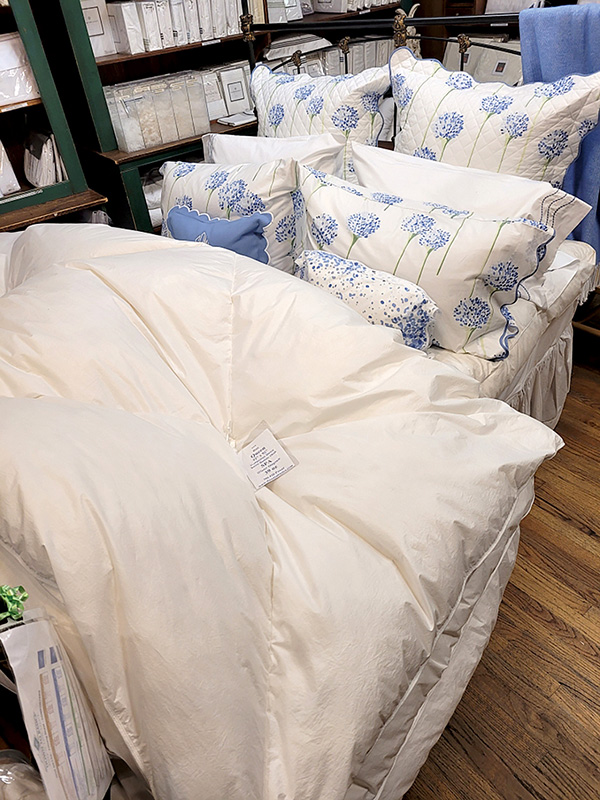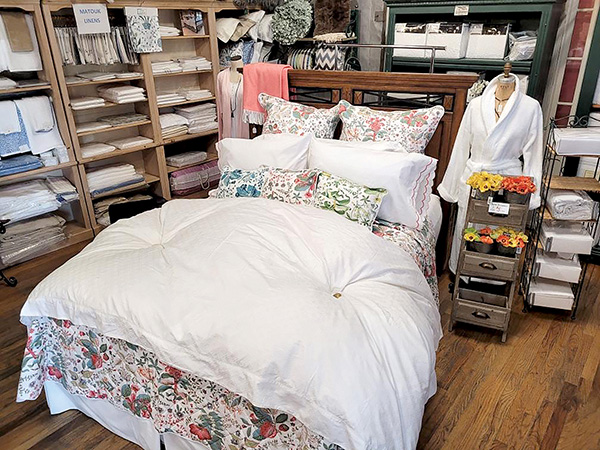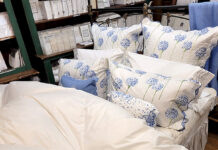
By Elizabeth Wulfhorst
RED BANK – This week’s weather may have belied the fact that autumn is almost here, but cooler temperatures really are just around the corner. And as the glow of summer begins to fade, it’s time to get cozy with the warmth of one of nature’s best insulators – down.
Most down comes from geese. It is the light, soft, fluffy coating made up of filaments and found under the birds’ feathers in clusters. Unlike feathers, though, down does not have quills. Feathers may be added to down products to provide additional insulation and support, according to the American Down & Feather Council.
Both down and feathers are “natural fill products that are breathable, durable and resilient,” according to the council, which notes that, in addition to providing insulation without a lot of weight, down is more environmentally friendly than synthetic materials. The manufacture of materials like polyester produces a much higher carbon footprint than natural down and feathers.
Many people who think they are allergic to down may actually be allergic to oil in the feathers’ quills, explained Susan Fowler, owner of Down to Basics at the Galleria in Red Bank. “It’s the quill that causes the sharpness and the pokiness and also the allergies,” she said.
Fowler knows a thing or two about down; her store has been operating in the Galleria for 30 years this month. Before that she ran other stores selling down products as well.
Fowler learned the importance of comfort at a young age, when she spent two years recovering from a spinal cord injury at age 12. “That probably has been one of my driving forces in this business,” she said, “just to be comfortable.”
As a young adult, a trip overseas solidified her obsession. “Basically, I went to Europe when I was 21 years old and slept under a down comforter and I thought I was in absolute heaven,” she said.
While Down to Basics supplies comforters to some of the ritziest hotels and spas in the country, Fowler says not to be intimidated by the cost.
“I think we have a reputation for being too expensive,” she said, “but we have comforters that start under $100 and go up to over $2,000 and everything in between.”
She recommends purchasing the best quality at the price point you feel comfortable with, noting that bedding is an investment. “You are in contact with your pillows and comforters for more hours than anything else,” she said, pointing out that if you sleep eight hours a night, that’s 2,920 hours in one year. Over the lifetime of the duvet, which can last 20-30 years depending on the quality, a large initial investment could turn into pennies a night.
“A glass of wine will give you maybe an hour of pleasure and it costs, what, $8, $10? Think of comparing that to what you spend on your down pillow and your down comforter that you’re with thousands of hours,” she said.
Aside from cost, Fowler recommends keeping certain other factors in mind when shopping for a down comforter.
First, there are different types of down. The store carries comforters made with Siberian goose down – the crème de la crème – Hungarian goose down and white goose down, but differences are also found in the outer shell the down is blown into and how the shell is sown to keep the down from shifting.
“You can have a lower quality shell which is a firmer, thicker cotton cambric and that adds to the weight and also the down can’t loft as much. So it doesn’t look as light and as fluffy as when you put it into a Swiss batiste fabric,” she said. “That’s very light so the Siberian down with all the little filaments can be lofty.”

The perfect combination will be different for each customer based on the look and feel they are trying to achieve. Some comforters are so light they are perfect for year-round use and some will be warm enough for the coldest Northeast winters.
Fowler recommends the store’s most popular Spa Winter Light comforter filled with the Hungarian down for a “great combination of coziness and practicality.”
No matter what combination of down and shell a customer chooses, the comforter, also called a duvet, should almost always be protected with a cover, which can come in an end- less choice of fabrics and patterns.
However, Fowler stresses a few important points: The cover should be light, airy and washable.
As anyone who has changed a duvet cover knows, the job can be equivalent to an Olympic workout. Fowler says to look for duvets and covers that have ties so the comforter stays put within the cover until it’s time to remove it.
When you are ready to wash the duvet, Fowler says a commercial washer and dryer is the best. “We take them to the laundromat,” she said, adding that she will also spot treat with commercial stain removers or bleach if needed. “I wash them in warm water and then drying is really important. Put it right into the commercial dryer because it’s big,” she said, and add “something hard” like a tennis shoe in a drawstring bag. This breaks up the clumps of down as it dries, so it will be lofty again. “Dry it for an hour and then dry it for an extra half an hour just to be sure it’s really dry.”
As a final note, while it may seem sacrilege to most Americans, sleeping without a top sheet is the perfect way to nod off with your down comforter.
“The best way to sleep is under the comforter with a duvet cover and no extra blankets or top sheets or anything like that, because the closer you are to the comforter, the more comfortable you are,” Fowler said.
A bonus? Without a top sheet, making the bed is no longer a chore. “You can stand at the bottom of the bed and just shake the duvet and, if you shake it a certain way, the top part turns over and you’re done,” she said.
This article originally appeared in the Sept. 16 – 22, 2021, print edition of The Two River Times.














